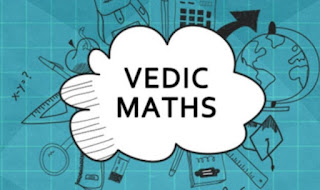VEDIC MATHS-85
VEDIC MATHS
By OMKAR TENDOLKAR
Hello friends,
This is post number 85 from the series of "Vedic maths" blogs. Here in this blog we will learn about "Auxilliary Fraction-II"
Reference:
We had already learn about "Types Of Decimals" in our previous blog. If you have missed my last blog then please visit "VEDIC MATHS-83".
We had already learn about Reciprocals of Numbers Ending in 9 in "Auxilliary Fraction-I" in our previous blog. If you have missed my last blog then please visit "VEDIC MATHS-84".
Decimals:
Here in this post, we shall look at methods to convert fractions to decimals.
Vedic One-Line Method:
The conventional practice of converting a reciprocal or fraction into a decimal number involves the division of the numerator by the actual denominator. When the denominator is an odd prime number such as 19, 23, 29, 17 etc., the actual division process becomes too difficult; whereas, if we use the Vedic method, the whole division process becomes oral and the decimals of such fractions can be written directly.
We will now see additional techniques which can speed up the division of fractional numbers where :
- the dividend is less than the divisor and
- the divisor is small e.g. having 2 or 3 digits and
- the last digit of the divisor ends with 1, 6, 7, 8 and 9 E.g. of such divisors are 19, 29, 27, 59, 41, 67, 121 etc.
Other divisors ending in 2, 3, 4, 5 and 7 can be converted to such divisors by multiplying by a suitable number.
We will see examples of divisors ending in each of the digits from 1 to 9 to get a good insight into the entire process.
Reciprocals of Numbers Ending in 3:
We will first consider reciprocals of numbers ending in 9 such as 19, 29, 39, 79, etc.
12, 23 and 33 are some of the numbers ending with 3. To find out their reciprocals, we have to ensure that the denominator ends in a 9. To ensure that the denominator ends in a 9, we multiply the numerator and the denominator by 3.
NOTE: For all numbers ending with 3, we can convert them to numbers ending with 9 by multiplying by 3.
Example :
1.Convert the fraction 1 / 23 to its decimal form.
Step 1:
We multiply the numerator and the denominator by 3 and make it
Here our Ekadhika for 69 is 7.
1 / 23 = 1*3 / 23*3 = 3 / 69 = 0.3 / 7
Step 2:
Now, by the Vedic method, we will obtain the decimal form by dividing 0.3 by 7.
Here the starting point is 3 ÷ 7. As we cannot divide 3 by 7, we give a decimal point in the answer with 0 as quotient and remainder 3 to be written. This means our next dividend is 30.
1 / 23 = 0. 0......
3
Step 3:
We divide 30 by 7 which gives us 4 and remainder 2. The sum looks like this:
1 / 23 = 0. 0 4......
3 2
Step 4:
The quotient obtained is 24. We divide 24 by 7. This gives us our next quotient digit of 7 and remainder of 3.
We prefix 3 before 3 as shown below.
1 / 23 = 0. 0 4 3......
3 2 3
Step 5:
We keep on dividing by 7 and writing down the quotients and remainders as it has already been shown. And this is what we get:
1 / 23 = 0. 0 4 3 4....
3 2 3 5
Our answer becomes 0.0434.
Answer:
1 / 23 = 0.0434.
NOTE: if this process of division is continued, the same set of digits will start repeating. We stop dividing once we get the required number of decimal places.
2. Convert the fraction 1 / 13 to its decimal form.
Step 1:
We multiply the numerator and the denominator by 3 and make it
Here our Ekadhika for 39 is 4.
1 / 13 = 1*3 / 13*3 = 3 / 39 = 0.3 / 4.
Step 2:
Here the starting point is 0.3 ÷ 4. As we cannot divide 3 by 4, we give a decimal point in the answer with 0 as quotient and remainder 1 to be written. This means our next dividend is 30.
1 / 13 = 0. 0......
3
Step 3:
We divide 30 by 4 which gives us 7 and remainder 2. The sum looks like this:
1 / 29 = 0. 0 7......
3 2
Step 4:
The quotient obtained is 27. We divide 27 by 4. This gives us our next quotient digit of 6 and remainder of 3.
Our sum now looks like this:
1 / 13 = 0. 0 7 6......
3 2 3
Step 5:
We keep on dividing by 3 and writing down the quotients and remainders as it has already been shown. And this is what we get:
1 / 13 = 0. 0 7 6 9.....
3 2 3 0
Our answer becomes 0.0769.
Answer:
1 / 13 = 0.0769.
Solve the following example.
1. 1 / 33
3. 1 / 53
Ans : 1 / 33 = 0.030303.
2. 1 / 43
Ans : 1 / 43 = 0.023255.
Ans : 1 / 53 = 0.018867.
The simplicity of this method can be vouched from examples given above.
You may try following examples.
1. 5/63
2. 7/33
3. 4/13
4. 7/23
5. 4/43
In next blog we will discuss about "Auxilliary Fraction-III".
Are you excited for this?...
Then, please wait for it.
I will post my new blog in next week.
We will meet very soon through our next blog. Till that stay connected, stay healthy and stay safe.
Thanks
for giving your valuable time.
Good day😊


Comments
Post a Comment